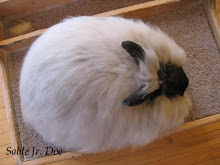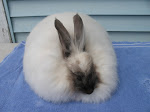--another post from the old blog
I took a close look at the nutrition labels on my feed bags the other day, and did a little reading up on what types of information a breeder could expect to glean from the 'Guaranteed Analysis' and 'Ingredients' list.
First of all, different feeds have different formulations depending on what the intended use is. Commercial Meat operations normally require a high protein feed that supports fast growth and an intensive breeding schedule (about 18%), while Wool herds require a high level of protein coupled with high fiber levels to encourage healthy gut motility and maximum wool growth (usually about 17-18%). Pet rabbits or rabbits who are not being bred or stressed in any way generally just require a 'maintenance' formula, which can be lower in both fiber and protein (15-16%). While ingredients and amounts on assorted labels may vary, the essential nutrients can be grouped into the following categories:
Protein
Carbohydrates
Fats
Minerals
Vitamins
These components are listed on feedbags in various orders, usually followed by (min) or (max) to show how much or how little of the ingredient is included. In the book 'Rabbit Production' a clear description of how to read a feed label is included:
"By law, a feed tag must provide certain information, varying somewhat by state or province. Crude protein is usually listed as "minimum" or "min." In other words, the feed manufacturer can provide more protein than listed on the tag. The manufacturer is not likely to consciously do so, as protein is expensive. Similarly, the crude fiber is listed as "maximum" or "max." Again, this is to protect the buyer. Fiber sources are generally cheaper than grains. By stating a maximum fiber level, the manufacturer assures the buyer that cheap, low quality fibrous feedstuffs haven't been added to dilute the feed. If the feed has less than the maximum fiber content listed, it means that higher cost ingredients have been used. As a result, rabbit feeds generally have protein contents very similar to the tag values, whereas crude fiber levels are often lower than listed. This regulation has caused misunderstanding by some rabbit raisers, who may want their feed to contain a particular fiber level. They would prefer that the tag read "minimum" for crude fiber. However, this is not required by feed regulations.
It is impossible to look at a feed tag and say conclusively that the feed is good or bad. The information provided is insufficient to allow a judgment to be made. Crude protein is not a measurement of protein at all, but a measure of nitrogen. There is no indication on the tag of the quality of the protein (its content of essential amino acids). There is no indication of the digestibility of the protein. A crude Protein analysis does not distinguish between soybean meal and shoe leather. There is no information on a feed tag about the energy content of the feed or about the specific level of minerals and vitamins." (pgs. 150-151)
Since we cannot get specific information from the 'guaranteed analysis' itself, it often helps to look beneath at what is contained in the ingredient list. First, the best source of roughage in rabbit feed is generally considered to be Alfalfa meal. While Alfalfa is an excellent source of high fiber, it is also significantly high in a type of protein that is well digested by rabbits. It is also an excellent source of phosphorus, calcium, and potassium, and contains indigestible fiber which is helpful in preventing enteritis. In addition to this, it contains vitamin A and carotene. Considered altogether, the virtues of Alfalfa usually make it the very first ingredient in high quality rabbit feeds.
Significant sources of grain (carbohydrates) are Corn, Wheat, Milo, Barley and Oats. Corn, wheat, and milo are high energy grains, while barley and oats tend to be on the lower end of the spectrum because of their fibrous hulls. Corn (especially) is not recommended for use in hot climates or during the summertime because of the possibility of gut imbalances leading to diarrhea, and barley and oats should be scaled back during the warmer seasons as well. Oats and corn are highest in fat content, while barley is the highest in fiber content. Corn is considered to be the highest energy grain available.
The best and most reliable source of protein in rabbit feed is Soybean meal. Soybeans (heated/roasted, never raw) are palatable to rabbits, have high digestibility, and are well balanced in amino acids. Other supplements for protein found in rabbit feed include Cottonseed meal, Sunflower meal, Rapeseed meal, Safflower meal, Linseed meal, and Peanut meal.
Additional ingredients found in rabbit feed are probiotics (to reduce growth of pathogens in the digestive tract), pellet binders (such as bentonite or lignin sulfonate), flavoring agents such as thyme or molasses, Salt (a necessary ingredient to satisfy sodium chloride and trace mineral requirements), Copper Sulfate (to inhibit growth of pathogenic bacteria in the digestive tract), Yucca Extract (to reduce the release of ammonia into the air and keep odor down in the rabbitry), and enzymes such as those found in pineapple and papaya to break down hairballs in the wool breeds.
A well formulated pellet will ensure that herds are kept healthy and productive in every capacity, but a poorly formulated one can result in a range of health problems, some of which can be fatal. The storage of feed is also very important. Bags must be stored in a dry location that is rodent proof, and pellets must either be kept in the bag or stored in metal or plastic bins. The milling dates of all feeds should be checked upon pickup, and anything older than 3-6 months should likely be discarded due to loss of vitamin content and the increased likelihood of rancidity (mold or toxins developing in the feed). The best feed is a feed that is freshly milled with the highest quality ingredients. If you use your rabbits as a guide, the freshest feed is also the one that is most readily eaten, while older pellets tend to offend a rabbit's sensitive palate and are often left sitting in the dish.
Sunday, November 22, 2009
Subscribe to:
Post Comments (Atom)























No comments:
Post a Comment